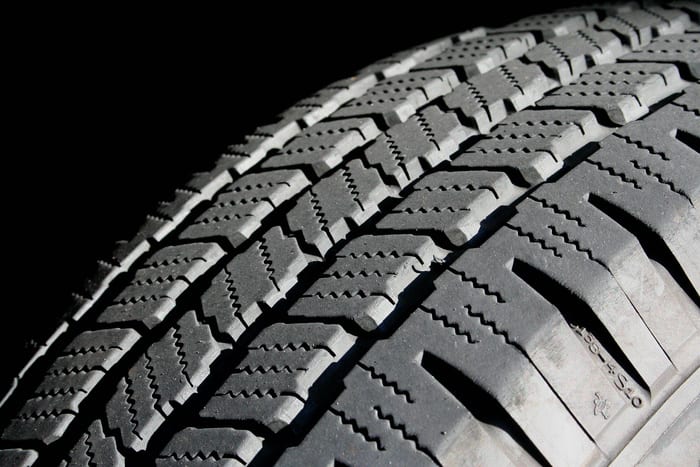
What is a tire tread and what types are there?
Content
- What is tire tread depth
- Methods for measuring tire tread depth
- Types of tire treads
- Seasonal classification
- Seasonal types of protectors
- What are spikes for?
- Classification of tires for SUVs
- How tire tread affects braking distance
- Impact of rubber wear
- Wear indicator
- Buying tires: new or used
- What is the risk of a car enthusiast buying used tires
- Related videos
- Questions and answers:
The tire tread is called an external element with a specific pattern, which is designed to provide an optimal contact spot for various road surfaces and the type of car. Also, the tread protects against cuts, punctures and other injuries while riding.
The tread differs in pattern, direction, thickness, quality of raw materials - these characteristics determine the seasonality of the tire, the type of road surface for which it is intended and the type of vehicle.
What is tire tread depth
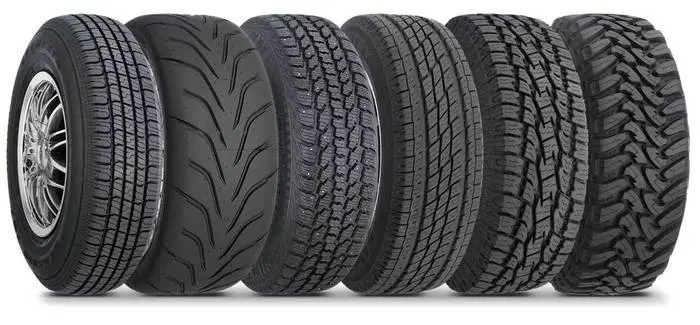
The tire tread depth refers to the distance from the bottom of the groove for water to the extreme upper point of the sole in contact with the road. During operation, the rubber wears out due to the rolling force and friction, respectively, the tread height also decreases. More advanced tires have a color indicator of wear, thanks to which you are always aware of the tread condition. However, most tires are not equipped with a useful function, which requires an independent replacement of the tread height, in more detail:
- it is generally accepted that the reference value of the minimum tread thickness is from 1.5 to 1.7 mm. In this case, rubber can be used, but its properties deteriorate significantly, the rubber leads, and the braking distance is increased. With a remainder of 1 millimeter or less, driving on such tires is dangerous, since they are already 80% out of service, which is especially noticeable in the rain. The average tire life is 5 years;
- for good winter tires with spikes, the tread height is 11 mm, but if more than 50% of the spikes have fallen out, it is dangerous to operate these tires, since the spikes are the main source of reliable grip here;
- for all-season tires, the minimum remaining height of the projector is 2.2 mm.
Minimum tread depth
So, the minimum tread depth is that at which tire operation is still possible. According to the rules of the road, a minimum balance is provided for each type of vehicle:
- for motor vehicles - 0.8mm;
- for trucks and trailers with a gross weight of more than 3500 kg - 1 mm;
- for cars weighing up to 3500 kg - 1.6mm;
- for buses (more than 8 seats) - 2mm.
Remember that when operating a tire with a minimal picture residue, you not only risk your life and health, but also other road users. With such wear, it is important to know the following rules:
- limit the maximum speed to one where you can safely brake if necessary;
- the braking distance has increased, so plan ahead for braking;
- Do not overload the vehicle with loads.
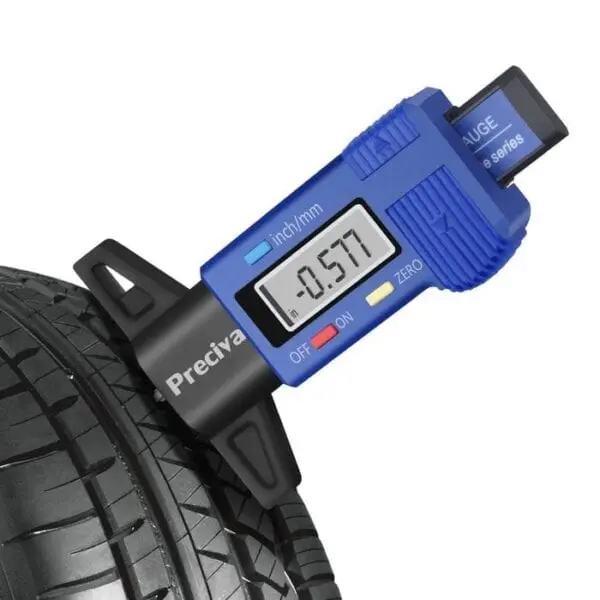
Methods for measuring tire tread depth
Today, there are several ways:
- using a coin, which gives an approximate picture of the residual thickness. For this, a coin of 10 kopecks is taken and put into the groove;
- ruler - also helps to measure depth in “home” conditions, while you will get cleaner numbers and a clear understanding of the current state of the tire;
- The depth gauge is a digital gauge that shows the correct amount of tread remaining. If you do not have this device at hand, contact any tire shop or tire centers.
Types of tire treads
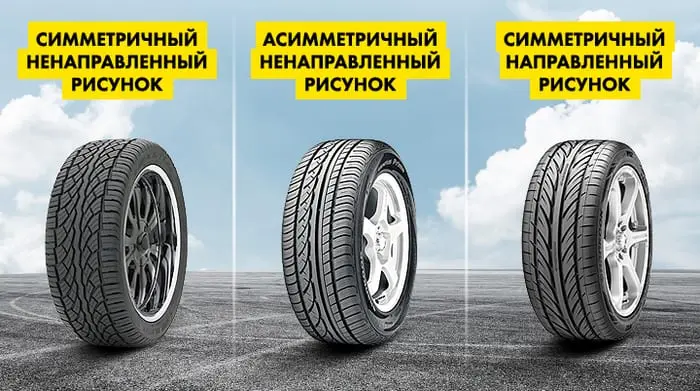
The modern tire market offers a huge number of options, so you have the opportunity to choose tires individually for your needs. The tread pattern is not just a whim of aesthetics, but carries important functions and responsibilities. Consider the types of protectors in detail.
Tires with symmetrical non-directional tread pattern
This is one of the most common types of drawing. The recesses of the pattern on the rim of the mirror mirror each other, that is, they are applied in parallel, and this makes it possible to install the rim on either side, that is, the tire does not have an outer or inner part. In addition to the mirror arrangement, such tires have the most balanced characteristics, namely: an excellent ratio of comfort and smoothness of movement, as well as minimal noise, the cost on the tire market is the most acceptable.
Tires with symmetrical directional tread pattern
This type of drawing provides the best water drainage, which means driving through puddles and wet roads, which means that the chance to “catch” aquaplaning (when the tire is in contact with the water surface and not the road, the car seems to float) is minimized. Often these tires have high-speed characteristics, a speed index of up to 300 km / h, but here the pattern is directional, as indicated by the Rotation inscription. Such tires are ideal for cars whose top speed reaches 300 km / h, as well as for rainy regions. Differs in higher cost and also premium quality of performance.
Tires with universal tread pattern
Such a tire has a pattern in the form of checkers, honeycombs and ribs. They are great for conditional off-road conditions, have soil-engaging characteristics, and the tread is characterized by high depth. Suitable for use on any type of pavement, primer, sand and dirt. It is installed on most trucks such as dump trucks, you can also meet them on PAZ-32054 buses, Soviet GAZ-53, ZIL-130 trucks.
Tires with all-weather tread pattern
This type of automotive rubber has an asymmetric pattern. This makes it possible to combine two main characteristics - confident grip in winter and excellent handling in summer. The inner part of the tread has a reinforced block, and the outer part has a reinforcing rib.

The peculiarity of these tires is that the full characteristics are manifested in the temperature range from -10 to +10 degrees. Otherwise, these tires are quite “average”, not able to fully provide the necessary at a certain time of the year: in summer there will be increased noise and faster wear, in winter there will be worse cross-country ability and handling.
Tires with asymmetric tread pattern
There are two types of rubber: with directional and non-directional pattern. Omnidirectional perform well in situations where the car at high speed quickly rebuilds and goes through long corners. To do this, reinforced the sidewall, so comfort due to increased noise is reduced. The tire has a direction, as evidenced by the inscriptions on the sidewall: Outer (outer side), Inner (inner).
The asymmetric directional pattern is the most advanced, thanks to the fact that the tire is instantly cleared of water and dirt, providing an ideal ride and comfort.
Same tread patterns
Despite the large selection of manufacturers, tire tread patterns can often match for some brands. This, for example, occurs in the case of the release of sub-brand products. Here is a list of brands that often have 100% identical tread patterns:
- Bridgestone's budget sub-brands include Seiberling, Dayton, and Saetta;
- Models of the middle segment from manufacturers Kumho and Marshal;
- Michelin budget sub-brands include: Strial, Riken, Orium, Kormoran, Taurus, Tigar;
- In Continental's Nordman line, every new addition is an exact copy of a model from the old line. In fact, these are previously flagship models, but now located in the budget segment;
- Cordiant and Tongue.
Partially similar tread patterns can be found among the following manufacturers:
- Some mid-range Michelin sub-brand models: BFGoodrich and Kleber;
- Sumitomo and falcons;
- Among the budget sub-brands of Continental, especially in the lines among the new products: General, Gislaved, Viking and Matador;
- All models of the middle segment are similar to those of the Kumho and Marshal brands;
- Goodyear's budget sub-brands include Debica, Sava, Braum and Kelly.
If we talk about Chinese manufacturers, then among the products of such brands you can find an analogue, only under a different name.
Seasonal classification
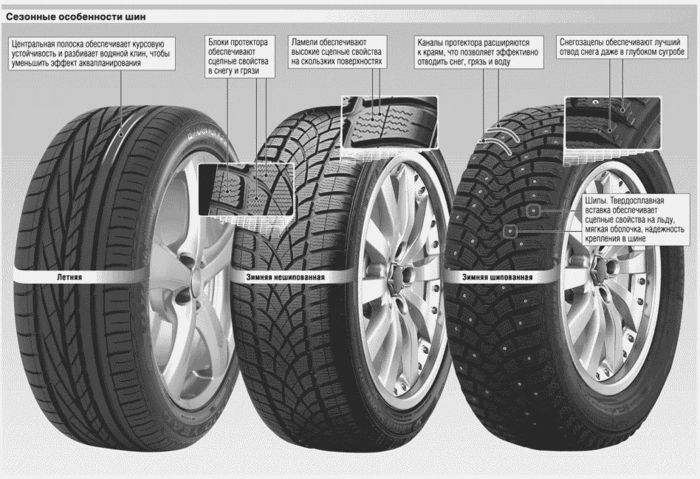
Among other characteristics, car tires are classified by season, i.e. summer, winter and all season. It is extremely important to observe seasonality, which in the future will increase the life of the rubber, while the tread wears out optimally and evenly, safety and smoothness remain at a high level.
Differences between winter and summer tires
Summer tires are made of a special composition that allows it to operate at high temperatures. In addition to the high temperature of the asphalt, when the tire is moving, it heats up from hot brake discs and due to friction. Unlike the winter one, the summer tire is tough, due to which it improves the coefficient of friction, and also fully provides a dense contact spot.
At temperatures below zero, such a tire becomes “oak”, none of the characteristics appear, the car instantly skids, steering and braking control is lost.
The winter tire has a deep tread, as well as the ability to maintain elasticity at extremely low temperatures. The softness of the tire provides comfort, while the studs, Velcro and high tread provide excellent grip on snow and ice, reducing the braking distance and minimizing the chance of skidding.
All season tires
These tires are used by motorists living in regions with a temperate climate. The advantage of such tires is that they do not need to be changed with the transition to another season. But the optimum operating temperature for such rubber is between +10 and -10 degrees.
If it is very cold outside or it snows, you can’t ride on such tires. A driver may receive a fine for driving on tires that are not suitable for the season (more about winter) if they do not have one of the following markings:
- Drawing of a mountain top with a snowflake inside;
- Different combinations of M and S symbols: MS, M+S or M&S.
Considering that the all-weather season is subjected to various kinds of loads at different temperature conditions, it can last up to 4 years. Such tires wear out more strongly in the hot summer - riding on it is akin to driving on winter tires. If the remaining tread depth is about 2.5 millimeters, all-season tires must be replaced.
Seasonal types of protectors
Seasonal tires are characterized not only by a special rubber composition. Each type will have its own type of tread pattern. For example, summer tires will have a tread pattern that provides the best grip and eliminates (as far as possible) the effect of aquaplaning.
Winter tires are characterized by a pattern that provides greater softness for better grip on slippery surfaces (for this, small notches are made on the sipes). Among the models intended for operation in the winter, the tread pattern is divided into two types:
- European;
- Scandinavian.
Consider the features of each of them.
Scandinavian type
Rubber of this type is the softest. Its pattern is characterized by diamond-shaped or rectangular blocks. The distance between them is great. This is explained by the fact that when driving on a snowy road, snow must be thrown out of the grooves. The edges of these blocks are sharp.
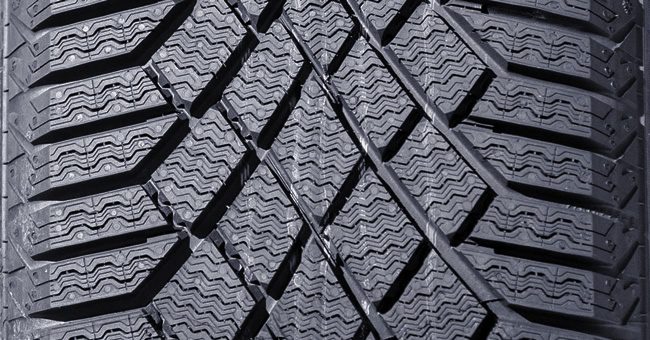
This structure allows for maximum grip on slippery roads. On snow, the tread perfectly pushes through the porous ball, provides a contact patch with the hard surface of the road. It is easy to ride on such tires if the streets in the city are poorly cleaned, and snowfalls in the region are a common occurrence.
European type
These tires are suitable for milder winters with little rainfall. They also do an excellent job with slippery roads, but if it is cleared of snow. To eliminate the effect of aquaplaning (in regions with mild winters, snow often melts on the roads, turning into a porridge with water), the tread has a smoother tread pattern that better drains water.
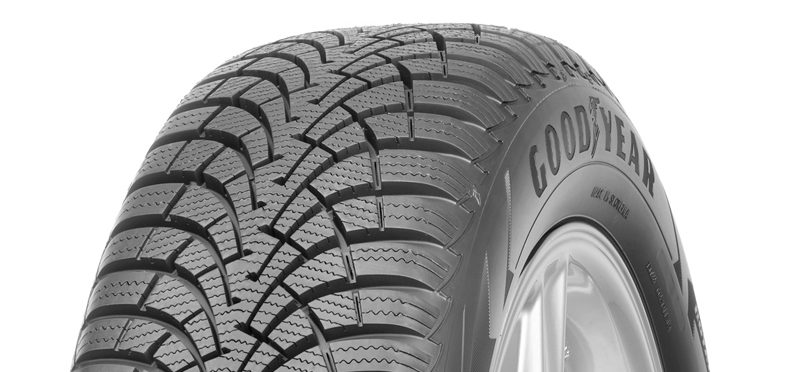
Compared to Scandinavian tires, European-type analogues are able to take care of about five seasons. Scandinavian tires often have to be changed after three seasons.
What are spikes for?
Often on the roads you can find cars with studded tires. These tires are effective on icy roads. If the roads are poorly cleaned, the snow melts during the day, and at night all this water turns into ice, spikes will come in handy in such conditions, especially for beginners.
But this type of rubber has a significant drawback - it is effective only on ice. If the car rarely hits the ice, then on clean asphalt the car will be unpredictable, especially during emergency braking. This is due to the fact that the spikes do not allow the soft part of the tire to catch on the asphalt, and the braking distance becomes much longer.
Classification of tires for SUVs
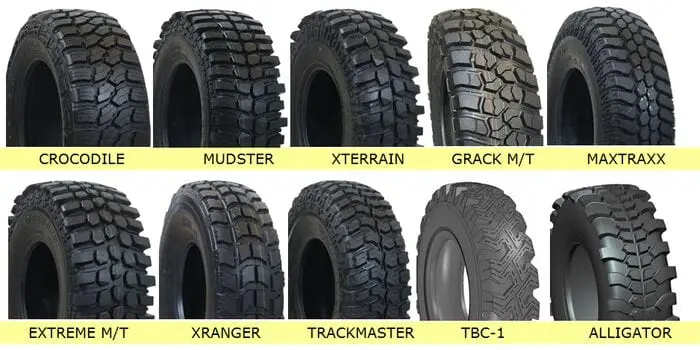
Tires for SUVs differ from others in many characteristics: the shape of the longitudinal and transverse tread patterns, dimensions, and stiffness. In addition to standard characteristics, off-road tires have their own values, which are described in more detail below.
A / T (ALL-TERRAIN) - for primer. This type of tire is universal, allows you to move on asphalt roads, dirt and moderate off-road. These tires are also called expedition tires. Due to the reinforced cord, the tires do not creep when the pressure is reduced. You can use All-Terrain on asphalt up to 90 km / h, then there will be maximum discomfort from stiffness and noise. It is with this type of tires that it is recommended to start your journey to off-road.
M / T (MUD-TERRAIN) - for dirt. It is an improved version of A / T due to the radial structure of the frame. The city / off-road operation ratio is 20/80. It is advisable to use such rubber on off-road, as the asphalt coating quickly erases the tread.
X / T (EXTREME-TERRAIN) - for extreme off-road. They have great potential where there are no roads, as well as the impossibility of driving on asphalt. Provides the best performance in mud, sand, dirt, swamps and snow. The use of extreme rubber significantly increases fuel consumption and also increases the load on the wheel bearings.
How tire tread affects braking distance
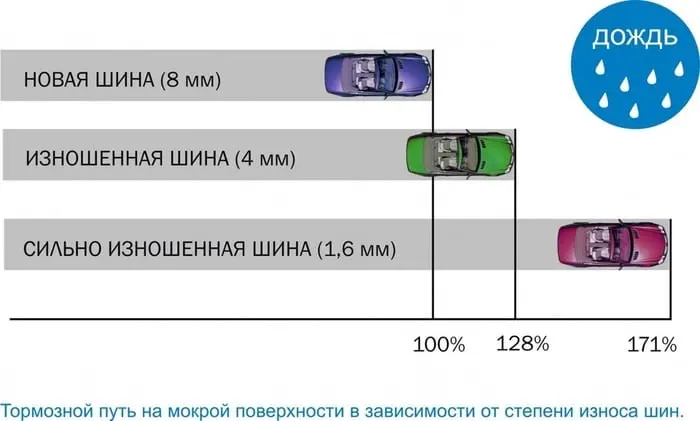
The tire model, tread depth and type of pattern significantly affect the stopping distance. The quality of raw materials as well as the performance depends on the model, how tenaciously the rubber will “hold on” to the asphalt, providing a contact spot.
The shorter the tread depth, when it comes to wear, the longer the braking distance by reducing the working surface, which ensures your safety. The drawing is no less important that in rain or mud it should take everything away from the tire to the side so as to prevent a “cushion” between the road surface and the wheel.
Choose tires according to the recommendations of the manufacturer of your car, and also do not use rubber before critical wear!
Impact of rubber wear
Tire wear is directly related to road safety. First of all, the degree of tread wear affects the braking distance: the more it is worn out, the longer the braking distance will be.
The reason is that a worn tread reduces traction. Because of this, the car can slip, slide (demolition or skidding). Uneven wear of the tread is especially dangerous, because in this case the contact spot tends to zero with an increase in the speed of the car.
Wear indicator
Many tire manufacturers, when designing a tread pattern, develop various kinds of indicators that signal the need to replace rubber and facilitate the procedure for measuring the residual height of the pattern.
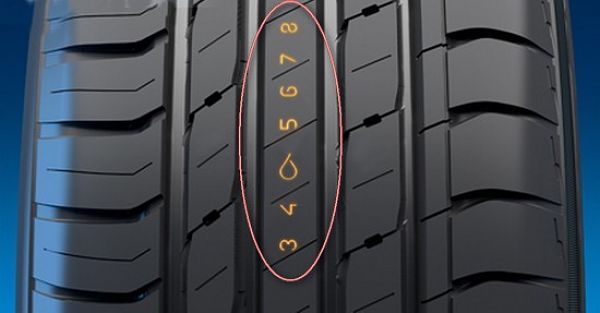
For example, numbers appear on some tire models. When the tread wears out, the top layer is erased, and another number is drawn at the next level. This marking allows you to quickly diagnose the tread depth without additional tools.
Buying tires: new or used
The purchase of any consumables, especially if safety on the road depends on them, is always associated with decent waste. For this reason, many motorists select tires for their car in the secondary market. On the hands you can find premium tires for modest money with acceptable tread wear.
Often sellers in their ads indicate that the tires are almost perfect, they departed only one season, and to confirm their words, they publish photos of the product washed and treated with silicone grease.
Before buying a "pig in a poke", you need to make sure that the rubber really matches the description. First of all, you need to pay attention to the residual tread depth. If the depth of the drawing on winter tires is 4mm, such rubber is already worn out and cannot be bought.
To determine the degree of rubber wear, you need to know exactly what tread depth the new analogue has. For example, for one rubber, 4 millimeters is 100% wear, and for products from another manufacturer of the same season, it is 60%. Each model has its own limit, at which it loses all its properties, even if it still looks decent compared to analogues.
What is the risk of a car enthusiast buying used tires
- When tires are bought on hand, no one will guarantee that they will last the prescribed period;
- One set can contain tires of different brands. If you are inattentive, then with an identical or similar tread pattern, you can not pay attention to the rubber model. Plus, the seller can cheat with the tread depth by cutting it on his own;
- The rubber may have been repaired or may have hidden damage. For example, finding a thin puncture is not always possible with a quick inspection of a tire;
- The tire could be stored incorrectly, for example, in the summer not in a dark room, but right in the heat;
- Often, when buying tires, it is impossible to immediately install them on the wheels. If deficiencies are identified, then it will not be possible to prove that the rubber was sold already damaged.
To choose the right tires and avoid cheating, you need to ask for help from a specialist. Road safety is not an area where you should save money.
Related videos
Here is a short video on how to choose tires for your car:
Questions and answers:
What is a tire protector for? This is the part of the tire that, firstly, prevents puncture of the main part of the tire, and secondly, it provides a stable contact patch with the road, even in the rain.
What residual tread is allowed? For a car - 1.6mm. For trucks - 1 millimeter. For buses - 2mm. For motor vehicles (mopeds, scooters, motorcycles) - 0.8mm.
What are the tire slots called? Transverse and longitudinal sipes form a tread pattern. These are called grooves, and they serve to drain water and dirt away from the contact patch. Small slots on the tread - sipes.

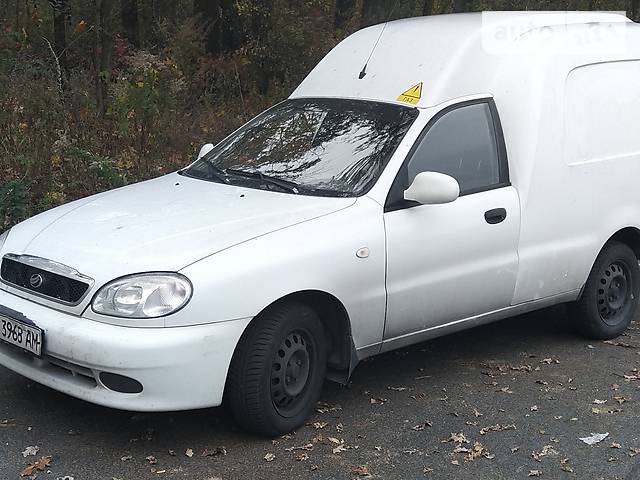
One comment
nina
Why does the air in the tire decrease?